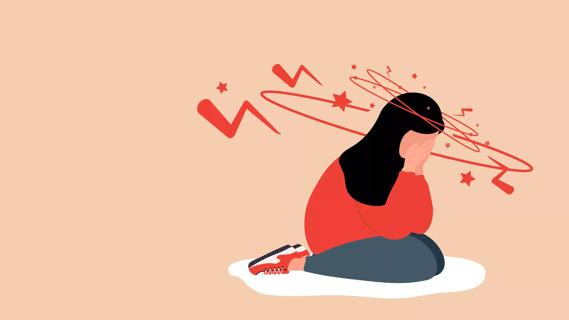A lack of energy, a sore or swollen tongue and eating non-food items are signs of a deficiency

I’m Popeye the Sailor Man,
I’m Popeye the Sailor Man,
I’m strong to the “finich,”
’cause I eats me spinach,
I’m Popeye the Sailor Man!
Advertisement
Cleveland Clinic is a non-profit academic medical center. Advertising on our site helps support our mission. We do not endorse non-Cleveland Clinic products or services. Policy
Readers of a certain vintage might remember the cartoon strips, radio programs, television shows and movies dedicated to a jaunty, corncob pipe-wielding sailor who accessed his super strength with the help of some canned spinach.
While the cartoon didn’t age particularly well, it did have a net-positive benefit on society: It convinced children to eat spinach! While all those canned greens didn’t give us superpowers, it did increase our iron intake. And that’s no small thing, given how common iron deficiencies are in children.
Pediatric gastroenterologist Kadakkal Radhakrishnan, MD, explains what iron is, how much your child needs each day and how to spot an iron deficiency.
Iron (Fe) is a mineral that our body needs to grow, develop and produce a substance called hemoglobin. Hemoglobin is a protein in your red blood cells that your body uses to carry oxygen through your body.
Our iron levels are determined by our diets. There’s an abundance of different foods that contain that all important mineral (including spinach). When we take in more than we need, our body is supposed to store the excess for use later. An iron deficiency can happen for two broad reasons:
Advertisement
If you’re not getting the iron you need, you’ll have low hemoglobin. That basically means that you’re not getting as much oxygen circulating in your blood as you should. While the symptoms are often subtle, they can, slowly but surely, add up to some pretty crummy health issues. More on them later.
The amount of iron a child needs to consume in a day depends on whether or not they have dietary restrictions. That’s because the iron found in meat, fish and poultry (heme iron) is easier for your body to absorb than iron from plant-based sources (non-heme iron).
Children assigned female at birth (AFAB) also require additional iron once they start menstruating.
The National Institutes of Health (NIH) Office of Dietary Supplements’ recommended daily allowance (RDA) of iron is:
| Age | People who eat meat | People who eat a vegetarian diet |
|---|---|---|
| Birth to 6 months | < 0.27 mg | < 0.5 mg |
| 7–12 months | 11 mg | 20 mg |
| 1–3 years | 7 mg | 12.5 mg |
| 4–8 years | 10 mg | 18 mg |
| 9–13 years | 8 mg | 14.5 mg |
| 14–18 years | 11 mg for male children15 mg for female children | 20 mg for male children27 mg for female children |
| Age | ||
| Birth to 6 months | ||
| People who eat meat | ||
| < 0.27 mg | ||
| People who eat a vegetarian diet | ||
| < 0.5 mg | ||
| 7–12 months | ||
| People who eat meat | ||
| 11 mg | ||
| People who eat a vegetarian diet | ||
| 20 mg | ||
| 1–3 years | ||
| People who eat meat | ||
| 7 mg | ||
| People who eat a vegetarian diet | ||
| 12.5 mg | ||
| 4–8 years | ||
| People who eat meat | ||
| 10 mg | ||
| People who eat a vegetarian diet | ||
| 18 mg | ||
| 9–13 years | ||
| People who eat meat | ||
| 8 mg | ||
| People who eat a vegetarian diet | ||
| 14.5 mg | ||
| 14–18 years | ||
| People who eat meat | ||
| 11 mg for male children15 mg for female children | ||
| People who eat a vegetarian diet | ||
| 20 mg for male children27 mg for female children |
“Iron is essential for your child’s development, and an iron deficiency can affect your child’s health and growth — and can even lead to anemia,” Dr. Radhakrishnan warns.
According to Dr. Radhakrishnan, iron deficiency is relatively common among children. It usually occurs for four main reasons:
Low iron levels impact your body in many different ways, which means there are a lot of different symptoms you can keep an eye out for. Dr. Radhakrishnan says the following symptoms can all indicate a deficiency:
If your kiddo’s displaying several of these symptoms, it’s time to visit their pediatrician for a formal assessment.
How does the pediatrician determine if your wee one’s iron is low? According to Dr. Radhakrishnan, you can expect them to do several different things during your appointment.
The doctor will start by getting a detailed history. As part of that process, they’ll likely ask you questions about your child’s nutrition — that is, what (and how much) they’re eating. They’ll also do a physical examination. If the pediatrician suspects your child has an iron-deficiency, they’ll order blood work to confirm it.
“While the most common cause of iron deficiency is inadequate dietary intake, these tests are necessary to precisely identify the deficiency’s cause,” Dr. Radhakrishnan adds.
Advertisement
Treatment of an iron deficiency typically involves iron supplements. Over-the-counter supplements will do the trick if the deficiency is minor. Dr. Radhakrishnan says your provider may provide prescription-strength supplements in more severe cases. It usually takes three to six weeks to build the iron reserves back up, but it could take up to three months of treatment, depending on the severity of the deficiency.
Once your child’s iron levels have been restored, the focus shifts to keeping it that way.
“Families dealing with iron deficiencies may benefit from the help of a pediatric dietitian to improve the dietary intake of iron-containing food,” Dr. Radhakrishnan says. “Vitamin C can also help improve absorption of iron, so this supplement could be valuable in conjunction with iron-rich foods.”
Of course, diet isn’t always the root of the problem. If it’s determined that your kiddo’s iron deficiency is the result of an underlying medical condition, your provider will either treat it themselves or refer your child to a specialist for additional care.
Although rare, it’s important to note that if your child’s hemoglobin levels become dangerously low, they may require more intensive treatment.
Advertisement
“Blood transfusions, iron injections and intravenous (IV) iron therapy all take place in a hospital,” Dr. Radhakrishnan explains.
If a person’s iron levels are low, they produce less hemoglobin, a substance that helps red blood cells carry oxygen throughout their body. That means your entire body is affected. Symptoms can range from fatigue and cold hands and feet to behavioral issues and appetite problems. In children, a lack of iron can also inhibit growth and development.
Iron deficiency is usually the result of poor nutrition, but it can also happen if your child has a major growth spurt, has a medical condition preventing proper absorption or is losing blood for some reason.
If you suspect an iron deficiency in your child, it’s important to see their pediatrician.
Advertisement
Learn more about our editorial process.
Advertisement

Iron plays a vital role in hair growth and health

Causes, symptoms and treatments

Bleeding is a risk and warrants taking care, but the reward of this lifesaving medication is great

Severe and debilitating headaches can affect the quality of your child’s life

With repeat injections over time, you may be able to slow the development of new wrinkles

Type 2 diabetes isn’t inevitable with these dietary changes

Applying a hot or cold compress can help with pain